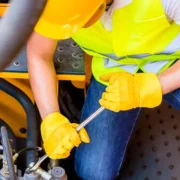
Various sectors like manufacturing, energy production, construction and logistics depend on industrial equipment for their primary operations. However, their natural deterioration process can lead to decreased performance, malfunctions, or total breakdowns.
When problems arise, you’re often faced with a critical decision: Should you repair or refurbish? The best decision requires an analysis of multiple factors, including equipment condition, cost investments, and operational requirements.
Repair vs refurbishment
Professional practices consider “repair” and “refurbishment” as distinct repair approaches that involve varying intensities of maintenance activity.
Repair
Equipment repair processes focus on fixing particular equipment components by changing broken parts, handling mechanical breakdowns, and troubleshooting electrical problems. This prioritizes quick operational restoration by targeting needed fixes.
Benefits of repairing equipment:
- Lower upfront cost.
- Quick turnaround, minimizing downtime.
- Ideal for minor or isolated issues.
Refurbishment
Refurbishment goes beyond simple repairs. It is a complete framework upgrade that follows specific restoration principles to achieve brand-new equipment conditions or surpass original specifications. The complete process includes deep cleaning followed by component replacement, system update, and technology incorporation to generate improved performance output.
Benefits of refurbishing equipment:
- Extended lifespan and improved reliability.
- Enhanced efficiency and performance.
- Opportunity to modernize outdated systems.
- Reduced need for frequent repairs in the future.
Considerations when choosing between repair and refurbishment
The extent of damage or wear
An assessment of your equipment’s condition will help determine whether basic repairs will solve the problem or if it needs comprehensive refurbishment. If the equipment has slight damage but the core systems function well, it indicates that a repair will likely give you the most affordable results.
On the other hand, multiple problems or an age-related decline in functionality make refurbishment stand as the superior long-term maintenance alternative.
Downtime and operational impact
Repair operations need less duration than refurbishment, thus becoming the best choice for maintaining brief facility outages. When excessive repairs result in ongoing interruptive maintenance, then investing in refurbishment can create a durable system and minimize discontinuity across extended durations.
Equipment age and obsolescence
Outdated equipment benefits from refurbishment because the new components and technologies modernize its functionality. Repair initiatives are counterproductive if efficient equipment operation extends beyond replacing parts.
Regulatory and environmental compliance
Typical warranty standards, safety regulations, and environmental norms sometimes require companies to repair older equipment. Improvements in machinery design improve safety features. This saves money through lowered fines and also decreases environmental impact.
Cost considerations
Finance plays the final deciding role for many choices. Repairs benefit your budget because they solve present difficulties before moving forward.
On the contrary, investing in a refurbishment now leads to enduring benefits through improved operational efficiency, longer equipment life, and reduced repair needs. This lowers maintenance costs in the long run.
Perform an evaluation of budget costs to choose the most appropriate financial option. Also, working with a trusted parts supplier like Kor Pak can make the repair or refurbishment process more efficient and cost-effective.
The final take
The decision to fix or revamp industrial systems rests on equipment state, financial constraints, and project duration targets. Repair is the best solution for minor problems in relatively modern equipment. Refurbishment provides a sustainable and economical pathway when equipment demonstrates age-related limitations or repeated malfunctioning.











